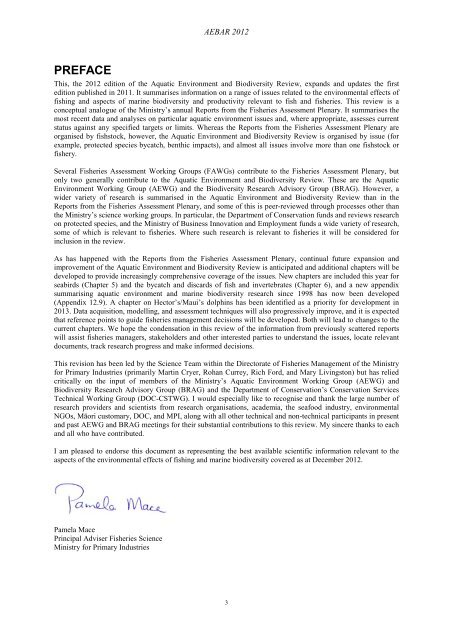Aquatic Environment and Biodiversity Annual Review 2012
Aquatic Environment and Biodiversity Annual Review 2012
Aquatic Environment and Biodiversity Annual Review 2012
Create successful ePaper yourself
Turn your PDF publications into a flip-book with our unique Google optimized e-Paper software.
AEBAR <strong>2012</strong><br />
PREFACE<br />
This, the <strong>2012</strong> edition of the <strong>Aquatic</strong> <strong>Environment</strong> <strong>and</strong> <strong>Biodiversity</strong> <strong>Review</strong>, exp<strong>and</strong>s <strong>and</strong> updates the first<br />
edition published in 2011. It summarises information on a range of issues related to the environmental effects of<br />
fishing <strong>and</strong> aspects of marine biodiversity <strong>and</strong> productivity relevant to fish <strong>and</strong> fisheries. This review is a<br />
conceptual analogue of the Ministry’s annual Reports from the Fisheries Assessment Plenary. It summarises the<br />
most recent data <strong>and</strong> analyses on particular aquatic environment issues <strong>and</strong>, where appropriate, assesses current<br />
status against any specified targets or limits. Whereas the Reports from the Fisheries Assessment Plenary are<br />
organised by fishstock, however, the <strong>Aquatic</strong> <strong>Environment</strong> <strong>and</strong> <strong>Biodiversity</strong> <strong>Review</strong> is organised by issue (for<br />
example, protected species bycatch, benthic impacts), <strong>and</strong> almost all issues involve more than one fishstock or<br />
fishery.<br />
Several Fisheries Assessment Working Groups (FAWGs) contribute to the Fisheries Assessment Plenary, but<br />
only two generally contribute to the <strong>Aquatic</strong> <strong>Environment</strong> <strong>and</strong> <strong>Biodiversity</strong> <strong>Review</strong>. These are the <strong>Aquatic</strong><br />
<strong>Environment</strong> Working Group (AEWG) <strong>and</strong> the <strong>Biodiversity</strong> Research Advisory Group (BRAG). However, a<br />
wider variety of research is summarised in the <strong>Aquatic</strong> <strong>Environment</strong> <strong>and</strong> <strong>Biodiversity</strong> <strong>Review</strong> than in the<br />
Reports from the Fisheries Assessment Plenary, <strong>and</strong> some of this is peer-reviewed through processes other than<br />
the Ministry’s science working groups. In particular, the Department of Conservation funds <strong>and</strong> reviews research<br />
on protected species, <strong>and</strong> the Ministry of Business Innovation <strong>and</strong> Employment funds a wide variety of research,<br />
some of which is relevant to fisheries. Where such research is relevant to fisheries it will be considered for<br />
inclusion in the review.<br />
As has happened with the Reports from the Fisheries Assessment Plenary, continual future expansion <strong>and</strong><br />
improvement of the <strong>Aquatic</strong> <strong>Environment</strong> <strong>and</strong> <strong>Biodiversity</strong> <strong>Review</strong> is anticipated <strong>and</strong> additional chapters will be<br />
developed to provide increasingly comprehensive coverage of the issues. New chapters are included this year for<br />
seabirds (Chapter 5) <strong>and</strong> the bycatch <strong>and</strong> discards of fish <strong>and</strong> invertebrates (Chapter 6), <strong>and</strong> a new appendix<br />
summarising aquatic environment <strong>and</strong> marine biodiversity research since 1998 has now been developed<br />
(Appendix 12.9). A chapter on Hector’s/Maui’s dolphins has been identified as a priority for development in<br />
2013. Data acquisition, modelling, <strong>and</strong> assessment techniques will also progressively improve, <strong>and</strong> it is expected<br />
that reference points to guide fisheries management decisions will be developed. Both will lead to changes to the<br />
current chapters. We hope the condensation in this review of the information from previously scattered reports<br />
will assist fisheries managers, stakeholders <strong>and</strong> other interested parties to underst<strong>and</strong> the issues, locate relevant<br />
documents, track research progress <strong>and</strong> make informed decisions.<br />
This revision has been led by the Science Team within the Directorate of Fisheries Management of the Ministry<br />
for Primary Industries (primarily Martin Cryer, Rohan Currey, Rich Ford, <strong>and</strong> Mary Livingston) but has relied<br />
critically on the input of members of the Ministry’s <strong>Aquatic</strong> <strong>Environment</strong> Working Group (AEWG) <strong>and</strong><br />
<strong>Biodiversity</strong> Research Advisory Group (BRAG) <strong>and</strong> the Department of Conservation’s Conservation Services<br />
Technical Working Group (DOC-CSTWG). I would especially like to recognise <strong>and</strong> thank the large number of<br />
research providers <strong>and</strong> scientists from research organisations, academia, the seafood industry, environmental<br />
NGOs, Māori customary, DOC, <strong>and</strong> MPI, along with all other technical <strong>and</strong> non-technical participants in present<br />
<strong>and</strong> past AEWG <strong>and</strong> BRAG meetings for their substantial contributions to this review. My sincere thanks to each<br />
<strong>and</strong> all who have contributed.<br />
I am pleased to endorse this document as representing the best available scientific information relevant to the<br />
aspects of the environmental effects of fishing <strong>and</strong> marine biodiversity covered as at December <strong>2012</strong>.<br />
Pamela Mace<br />
Principal Adviser Fisheries Science<br />
Ministry for Primary Industries<br />
3

















